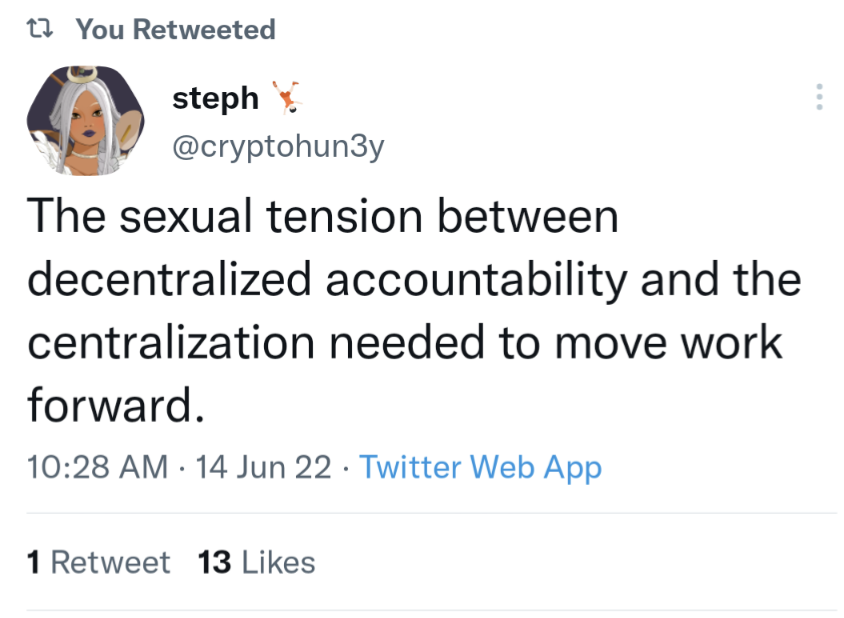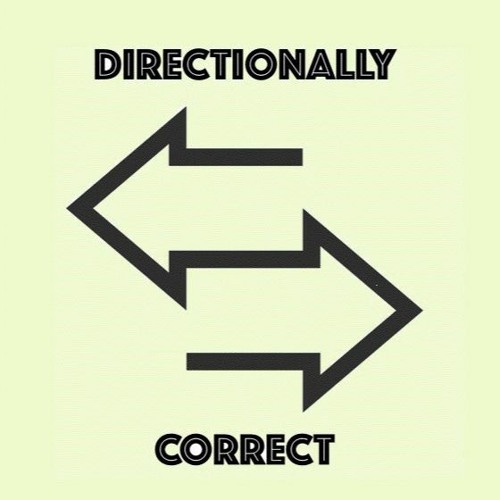NoDW #7: DAOs & Structural Adaptation Theory - Part 2
The Newsletter of Decentralized Work: Data-driven insights on the world of decentralized work
In this edition:
Our feature article: What DAOs can learn from Structural Adaptation Theory - Part 2
Big news from the talentDAO community
Elsewhere in Web3
Like what you’re reading? Consider supporting our efforts at talentDAO by becoming a paid subscriber.
What DAOs can learn from Structural Adaptation Theory: Part 2
By: Saulthorin
In part one of this series on Structural Adaptation Theory (SAT) we discussed the three types of organizational structure, how DAO structure is different from traditional organizations, the features of well-designed sociotechnical systems, and why DAOs are the next evolution of sociotechnical systems. In part two we will be diving into the details of SAT and three lessons DAOs can learn.
Let’s get started!
What is Structural Adaptation Theory?
Imagine you are driving a car on a recently developed highway system. During your leisurely ride, the fuel tank gauge indicates an estimated 137 miles left until your tank is empty. As you ride across the highway you see several gas stations with signs that read, “last exit for 50 miles.” These signs don’t really concern you because you know the vehicle can travel at least another 100 miles at given fuel levels. If something happens you can always turn back around and head to the last exit.
After some time goes by you realize your calculations were way off. You are going to run out of gas soon and be stranded with no exits within a reasonable walking distance. In a panic, you pull the car over to preserve fuel. With a sigh of relief, it occurs to you the previous gas station was not more than 10 miles behind you. Suddenly it hits you: you're on a one-way street and turning around is not an option.
The core idea of SAT is that organizational change is asymmetric. In the silly example above the assumption was made that the highway you were driving on was a two-way street but in fact was just a one-way. This made going back the way you came much more difficult. In other words, the distance from point A to point B is the same as the distance from point B to point A, but moving from point A to point B may be more difficult than moving it from point B to point A. Structural adaptation theorists refer to this process as “asymmetric adaptability” (Moon et al., 2004).
Many traditional organizations have fallen into the trap of assuming they were making structural design decisions based on two-way lanes when in fact they were driving on a one-way. The same trap is applicable to DAOs. Not all change is equal and some decisions will be harder to revert than others. People respond to change differently as well, with some changes being easier to tolerate than others. Structural Adaptation Theory is a series of studies that help provide some warning signs on how change might be affecting your organization's design process.
Three lessons DAOs can learn from SAT when designing organizational structure
Lesson #1: How you design DAO structure largely depends on how contributors self-organize and work is divided.
There’s no one right way to design a DAO but there is certainly a wrong way to do it. Creating work that is decentralized enough to provide autonomy yet prescriptive enough that it can be accomplished can be very difficult. The majority of individual DAO contributors are going to desire both autonomy and a clear path to contributorship. Most will not tolerate ambiguity so DAOs eventually start documenting their structure and how things are done. In a traditional organization, this might be called building your org chart or more specifically the departmentalization process.
Departmentalization is what most will think of when they picture organizational structure. It’s how you divide labor. This word is a bit outdated now because DAOs normally don’t even have departments. More common terms include guilds, pods, work units, and even entire sub-DAOs! I guess we should start calling it the daofication process instead.
When going through the daofication process you need to architect for emergence while at the same time operationalizing and scaling work effectively. Divisional and functional structure are two options available in which to design tasks. As tasks become more complex there becomes a greater need for both specialist and generalist roles within the DAO to accomplish the work. This will result in most DAOs having a mix of functional and divisional structures. What’s important is understanding the implications of choosing to switch from one to the next. The graphic below highlights the characteristics of divisional and functional structures and the difficulty of changing from one to the other.
Lesson #2: Designers of incentive structures should be weary of cutthroat cooperation
Novel compensation systems and incentive frameworks are available to DAOs thanks to the introduction of tokenomics and all the wonderful systems the blockchain has enabled. According to SAT individual-based reward structures promote speed but decrease accuracy while team-based rewards promote accuracy but decrease speed (Johnson et al., 2006).
With this in mind, you will likely want a combination of individual and team performance-based reward mechanisms in place for contributors. However, shifting incentive structures too drastically could result in unfavorable outcomes if not done carefully. Some studies found shifting from individual to team-based rewards resulted in a form of cooperation that looked far more competitive than it did team-based. The researchers referred to this as cutthroat cooperation.
If DAO contributors grow accustomed to receiving compensation based on their own merit, there may be resistance if performance expectations switch to that of team focus. It becomes very likely contributors will struggle not to feel at competition with their peers. Figuring out an incentive structure that balances both individual and team-based rewards is the challenge.
Lesson #3: Make sure the DAO is ready for decentralized decision-making because there’s no going back without difficulty.
According to SAT, moving from a centralized decision-making structure to a decentralized one is less difficult than the reverse direction (Hollenbeck et al., 2011). These results make sense intuitively. Once you give someone power or autonomy they are unlikely to want to give it back.
Most DAOs have taken decentralized decision-making to a whole new level. From polls, to open forum discussions, to blockchain voting, there are numerous solutions available to enable multiple forms of shared decision-making models. Yet many DAOs struggle to make decisions quickly despite having all these methods available to them. Building consensus is often a marathon not a sprint and the pain of DAO governance is known to many. Perhaps not everything should be a group decision after all. Unfortunately, most DAOs that come to this conclusion now need to move from a decentralized decision-making structure to a more centralized structure. Ouch.
I believe all DAOs should aspire to be as decentralized as possible with their decision-making processes. I also believe most community members don’t care about the majority of DAO decisions being made unless you ask them for an opinion. The challenge then for DAO operators is to determine which decisions should be decentralized and which ones should not. Choose wisely because once you create norms that a certain decision is decided democratically it is nearly impossible to remove power away from voters without strong resistance. This is why a gradual progressive decentralization strategy works best for most DAOs.
I’ve summarised the three lessons into the graphic below to make it a bit more digestible for the skimmers out there.
Conclusion
The number of DAOs has exploded over the last two years and there is no shortage of different design recommendations on how to structure work, incentives, and decision making. Structural Adaptation Theory provides a series of recommendations based on the assertion that organizational change is an asymmetric process, meaning it is harder to go back the way you came. In most cases, a gradual progressive decentralization strategy will work best for decision-making and work design considerations. Incentive systems will likely benefit from both individual and team-based rewards but designers should be weary of cutthroat cooperation if moving from compensating individual contributions to team accomplishments.
Where we go from here is really up to us. We can learn from past research but it does not have to define our future journey. Still, after a year of watching DAOs mature, it seems most are being faced with many problems traditional organizations have experienced. Where DAOs differ is the solutions available to solve them. I just hope we work towards architecting more two-lane highways instead of one-way streets. Only then will we be able to realize the full potential of decentralization without the pain of asymmetric adaptations. I guess it’s safe to say that DAOs are TBD.
Big news from the talentDAO community
Our first workshop: DAO 101
We are thrilled to announce our first talentDAO workshop - DAO 101 led by our very own @LisaWocken. If you’re looking for a practice, research-based look into the world of DAOs, you do not want to miss this one. September 14th, 9:30-11:10am CST.
DAOs, Web3, and the Future of People Analytics
For our auditory-inclined readers, our very own @saulthorin was on the Directionally Correct podcast talking DAOs, Web3, and the Future of People Analytics. If you’re a people analytics nerd like many of us, you’d want to check this one out.
DeSci & talentDAO
Here’s another ear candy for the governance and DeSci aficionados: @saulthorin was also on the Crypto Sapiens podcast discussing her Bankless DAO journey and most recent Governance Solutions Engineer role, the talentDAO genesis story and how can DAOs avoid the diversity and inclusion issues that are plaguing the science community.
Elsewhere in Web3
DAO Dash launches DAO health analytics in Discord / The DAO Dash team
The DAO Dash team announced a big upgrade to their tool: a conversational interface in Discord supporting DAO community members in improving the health of their DAOs using on-chain and off-chain data insights. Nominate your DAO to join their private beta here.
What We Can Learn from Decentralized Community Building / Bethany Crystal
Bethany Cyrstal dives deep into 12 different web3 communities and distills key lessons for web3 founders & builders on how to get started, how to decentralize how work gets done, how to convert people into participants and builders, and how to measure success.
Efficient DAO Design / 0xJustice
A regular on this newsletter, 0xJustice with another deep post on the innards of making DAOs work: what is efficient design? what are its key properties? what inspiration can we draw from existing organizations? and how might we apply efficient design to DAOs? All this and more in this article.
The Problems of DAO Governance / Jihad Esmail
Earlier this month, Orca and Other Internet teams brought together web3 governance practitioners and experts for a two-day summit centered around governance and coordination beyond the crypto ecosystem. In preparation for the event, a comprehensive survey was conducted to understand how governance challenges are currently emerging. This post outlines the results and key findings from the survey.
What do I think about Network States / Vitalik Buterin
Since the release of Balaji Srinivasan’s The Network State book in early July, it’s been a hot topic in web3 circles. Vitalik’s posts are often a good way to get a crisp, concise download on a particular topic, as well as his personal thoughtful, and well-articulated take on it. This post is no different.
🙏 Thanks to Our Sponsor
Opolis is building a next-generation employment ecosystem for the self-sovereign worker through The Employment Commons cooperative. This ecosystem allows freelancers and gig workers everywhere to access the same health benefits, life and disability insurance, and other services that only corporate employees have had access to traditionally. Visit opolis.co for more information, and be sure to tell them talentDAO sent you!
Like what you’re reading? Consider supporting our efforts at talentDAO by becoming a paid subscriber.

















